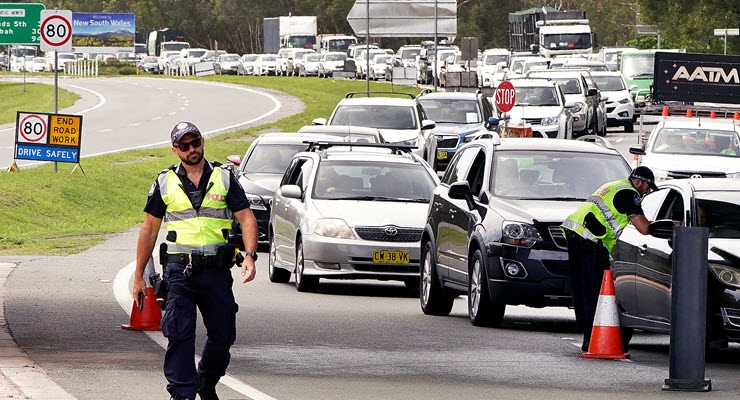
In crude parlance, Queensland has been caught with its pants down with its once-over-lightly COVID response. Widely applauded nationwide for stopping the pandemic spreading north, it has shown to have just one policy trick: shut the borders.
That might have been highly successful last year — playing a states’ game and shutting out Victorians and those from New South Wales who might inadvertently bring the virus into Queensland.
And it certainly was uncompromising. Those with sick relatives were forbidden entry, as well as children wanting to attend their parents’ funerals, and parents whose children were stuck in boarding schools.
Queensland’s success — and leadership — seemed in stark contrast to Gladys Berejiklian and her Ruby Princess cruise ship fiasco and Daniel Andrews and his hotel quarantine stuff-up.
But now, as southerners (except those from greater Sydney) take advantage of Queensland’s open borders and sunny summer skies, the picture unfolding of Queensland’s pandemic policy is anything but glowing. Take these examples:
- Visiting Victorians were told this week by Queensland’s chief health officer Dr Jeannette Young to get tested, and hundreds followed that advice. But testing stations were not informed, resulting in six-hour queues and people being turned away. Some said they won’t bother returning to be tested. The state’s response? Victorians picked the wrong clinics and should find one that’s less busy. How might they do that? Visit the government website. But some said the website was sending them to be tested 100 kilometres away, or demanding a doctor’s referral
- Perhaps feeling smug that cases were so low, Queensland testing stations have closed over recent weeks and result times ballooned to 36 hours. Some people waited 72 hours. The advice given by clinics varies widely. One clinic advised a couple they could have 100 people at their home while someone was in the same home waiting for the result of a test. Even if this is within the law, it’s preposterous. The list of policy hypocrisies runs to pages, but was highlighted this week when empty churches were shown against chaotic shopping scenes
- Contract tracing in Queensland was put to the test once, and failed. In part that was because diners and cafe-goers were not registering. The response by Premier Annastacia Palaszczuk was to launch a scathing attack on patrons. But why didn’t she wonder why her policy was not being policed? The government has now moved to demand electronic registration, but this week in south-east Queensland I visited a cafe, a beautician and a doctor’s surgery, none of which required me to log my attendance.
Those failures are a spectacular illustration of how Queensland’s response has been more about talking the talk then walking the walk.
The communication is right: “Complacency is the enemy, vigilance is our friend,’’ Acting Premier Cameron Dick said on Monday. But that only works if the government is committed to a policy that goes beyond shutting the gates to the state. And at the moment it’s not even doing that.
And on every test so far, it’s been found to be wanting.
The past few days has provided insight into how Queensland might cope if it faced the challenges seen in NSW and Victoria over recent weeks and months.
Our smugness has won us few friends. It’s hard to imagine Berejiklian going out of her way to extend the hand of help when Palaszczuk has ignored all political pleas for empathy.
Queensland’s response was “tinder waiting for a bushfire’’, one GP told me yesterday. Her point was that we are not prepared, saying is not doing, and we are in real strife if a COVID pocket erupts here like it has in southern states.
It’s bushfire season in Queensland too. We’re not talking bushfires this year; it’s floods and COVID. And in the absence of any real policy depth, the best plan seems to be hope.








Classic Madonna King, at her anecdotal, ideological, non analytical best. Thought I would give her a New Years retry, but will return to years of not bothering. So disappointed with Crikey.
Madonna King is published by Crikey for balance.
Along with most Queenslanders I rely upon the advice given by Janette Young, the Chief Health Officer and it always appears to be logical, sane and balanced.
The approach to lock downs is basic good sense.
If you can stop everyone from moving around, and wearing a mask if someone has to move about, while the contact tracers can get to work, test the closest contacts and wait for the results.
It makes it so much easier to control and mostly prevent major outbreaks.
As a born and bred Queenslander who has weathered a few cyclones in her time, I know that Queenslanders pull together in bad times and we try to leave no one behind.
It is easy to look at actions taken, and, with the benefit of 20/20 hindsight, be critical of the decisions taken during differing scenarios.
Closed borders save lives.
The Qld premier suggested to the NSW premier that a temporary border be moved further south so that the NSW people could access health care in Queensland, as they have been doing for years. Gladys refused!
Madonna can carp and criticize as much as she likes, if she wants to be relevant she should have a look at the number of deaths in aged care facilities, which are apparently funded and supervised by the Federal government.
This is dreadful. This is Crikey where you are supposed to accurately cite examples in support of your opinions. Instead we get Trumpisms like “some said” they couldn’t be bothered waiting for a test or researching what they were meant to do, complaints that results waiting times “ballooned” to only 75% of the standard, and an imaginary contact tracing fail. Also, there was a ‘scathing attack’ which, if you watched the press conference, was nothing of the sort. We’re the only jurisdiction in the world to stop an outbreak in a correctional centre (while simultaneously stopping one in a hospital and a nursing home) but, oh no, Madonna’s [imaginary?] GP thinks there is a problem.
Blimey…. seems no matter what, media do not like to focus upon NSW but prefer to bag QLD, Vic and WA implying Labor states are not competent.
Further, even articles focusing upon NSW cannot help but seguing to Victoria and almost trying to suggest some blame for NSW cases etc.; presently it’s the opposite.
Maybe the author of this article could look at why has the Federal Govt. not taken active responsibility for thier actual responsibilities i.e. managing national borders and quarantine, yet still seems shambolic round airport international arrivals?
Queensland did have an outbreak which was handled very well except for the publication of people’s names by the local press.
. There is a process for having a COVID test, and really this is hardly the only place with long delays. Check NSW / Vic at times of emergency. The boarder is still open for a large part of NSW and Victoria.
Author of article, Madonna King.Thanks, but I’ll pas.